
The Pentatomoidea are a superfamily of insects in the Heteroptera suborder of the Hemiptera order. As Hemiptera, they share a common arrangement of sucking mouthparts. The roughly 7000 species under Pentatomoidea are divided into 21 families. Among these are the stink bugs and shield bugs, jewel bugs, giant shield bugs, and burrower bugs.
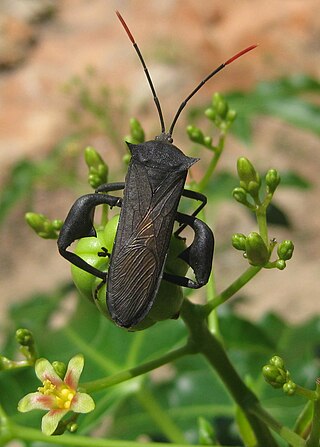
Coreidae is a large family of predominantly sap-sucking insects in the Hemipteran suborder Heteroptera. The name "Coreidae" derives from the genus Coreus, which derives from the Ancient Greek κόρις (kóris) meaning bedbug.

Scutelleridae is a family of true bugs. They are commonly known as jewel bugs or metallic shield bugs due to their often brilliant coloration. They are also known as shield-backed bugs due to the enlargement of the thoracic scutellum into a continuous shield over the abdomen and wings. This latter characteristic distinguishes them from most other families within Heteroptera, and may lead to misidentification as a beetle rather than a bug. These insects feed on plant juices from a variety of different species, including some commercial crops. Closely related to stink bugs, they may also produce an offensive odour when disturbed. There are around 450 species worldwide.
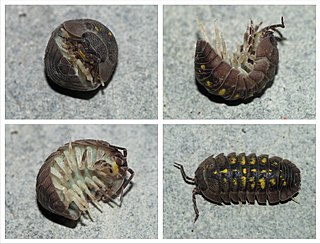
Armadillidiidae is a family of woodlice, a terrestrial crustacean group in the order Isopoda. Unlike members of some other woodlice families, members of this family can roll into a ball, an ability they share with the outwardly similar but unrelated pill millipedes and other animals. This ability gives woodlice in this family their common names of pill bugs or roly polies. Other common names include slaters,potato bugs, butchy boys and doodle bugs. Most species are native to the Mediterranean Basin, while a few species have wider European distributions. The best-known species, Armadillidium vulgare, was introduced to New England in the early 19th century and has become widespread throughout North America.

Belostomatidae is a family of freshwater hemipteran insects known as giant water bugs or colloquially as toe-biters, Indian toe-biters, electric-light bugs, alligator ticks, or alligator fleas. They are the largest insects in the order Hemiptera. There are about 170 species found in freshwater habitats worldwide, with more than 110 in the Neotropics, more than 20 in Africa, almost as many in the Nearctic, and far fewer elsewhere. These predators are typically encountered in freshwater ponds, marshes and slow-flowing streams. Most species are at least 2 cm (0.8 in) long, although smaller species, down to 0.9 cm (0.35 in), also exist. The largest are members of the genus Lethocerus, which can exceed 12 cm (4.5 in) and nearly reach the length of some of the largest beetles in the world. Giant water bugs are a popular food in parts of Asia.
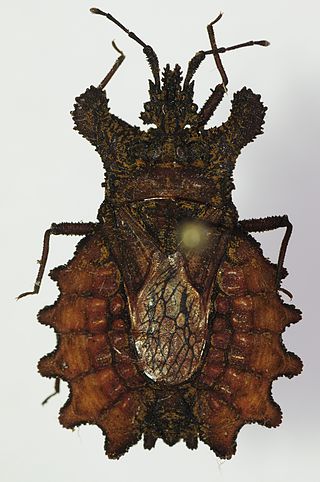
Aradidae is a family of true bugs (Heteroptera). Members of the family are commonly known as flat bugs due to their dorsoventrally flattened bodies. With few exceptions, these cryptic insects are of no economic importance.

Schinia, commonly called flower moths, is a large genus of moths belonging to the family Noctuidae. The genus has a Holarctic distribution with the vast majority of species being found in North America, many with a very restricted range and larval food plant.
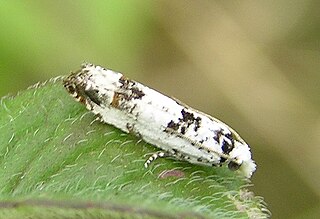
Eucosma is a very large genus of moths belonging to the family Tortricidae. Some taxonomies place a number of species in the genus Eucopina. The genus has a Holarctic and Indomalayan distribution. Even in well-studied Europe and North America, new species are still regularly discovered. There are at least 670 described species in Eucosma worldwide.

A woodlouse is any crustacean belonging to the suborder Oniscidea within the order Isopoda. They get their name from often being found in old wood, and from louse, a parasitic insect, although woodlice are neither parasitic nor insects.

Ploiariolini is a tribe of thread-legged bugs, comprising 16 genera and 142 described species. Ploiariolini has a worldwide distribution.
Empicoris seorsus is a species of thread-legged bug endemic to New Zealand. It is one of four species of Empicoris present in New Zealand.
Empicoris subparallelus is a species of thread-legged bug found in Cuba and from two Southern US States.

Empicoris is a cosmopolitan genus of thread-legged bug (Emesinae). Numerous species have been described.
BugGuide is a website and online community of naturalists, both amateur and professional, who share observations of arthropods such as insects, spiders, and other related creatures. The website consists of informational guide pages and many thousands of photographs of arthropods from the United States and Canada which are used for identification and research. The non-commercial site is hosted by the Iowa State University Department of Entomology. BugGuide was conceived by photographer Troy Bartlett in 2003 and since 2006 has been maintained by John VanDyk, an adjunct assistant professor of entomology and a senior systems analyst at Iowa State University. The website has been recognized for helping change the public perception of insects.

Rhyparochrominae is a subfamily of dirt-colored seed bugs in the family Rhyparochromidae. There are more than 410 genera and 2,000 described species in Rhyparochrominae.
Empicoris orthoneuron is a species of thread-legged bug in the family Reduviidae. It is found in Central America, North America, and South America.
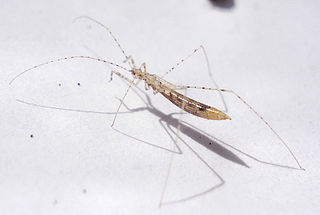
Empicoris vagabundus is a species of thread-legged bug in the family Reduviidae. It inhabits deciduous trees, where it hunts for prey such as barklice.
Empicoris errabundus is a species of thread-legged bug in the family Reduviidae. It is found in the Caribbean, Central America, and North America.

Aepophilus is a monotypic genus of bugs, containing the species Aepophilus bonnairei in the monotypic subfamily Aepophilinae in the monotypic family Aepophilidae of the infraorder Leptopodomorpha. It is found on the Atlantic coast of Europe.














